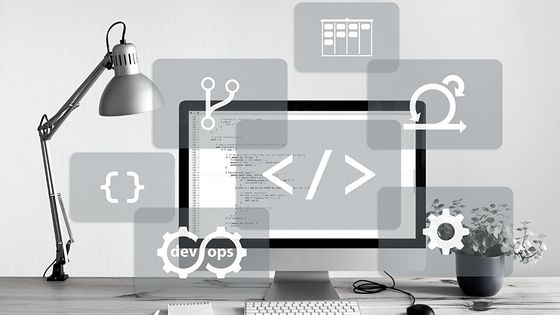Does this content probably interest you? Chances are you’re no stranger to the term DevOps. But do you really know what DevOps entails? Do you practice it in your own company? Or maybe you always wanted to start implementing it but didn’t know how to go about it?

The whole purpose of DevOps is to break down silos and put in place systems that encourage different teams to work together.
For the purpose of this theme, we may slightly look into some concepts for a better understanding.
-
DevOps: simply refers to a set of practices that combine software development (Dev) and IT operations (Ops). It is often characterized by the key principles of shared ownership, workflow automation, and rapid feedback.
In technical terms, DevOps refers to a set of practices intended to reduce the duration between carrying out a change in a system and the change being a part of normal production and still maintaining its high quality.
-
SAFe: simply refers to the world’s leading framework for business agility. The Scaled Agile Framework (SAFe) is a system for implementing Agile, Lean, and DevOps practices at scale. The Scaled Agile Framework is the most popular framework for leading enterprises because it works: it’s trusted, customizable, and sustainable.
-
On-premise software: also referred to as on-prem software is the type of software that requires an enterprise to purchase a permit or copy of the software to be able to have access to it.
This type of software operates from a customer’s in-house server, that is, it utilizes the company or organization’s native computing resources. It is simply a method of installing software.
A typical example is how computer games are installed right on users’ computers through CDs or USB drives. However, with off-prem software, the installer can be found anywhere on the Web.
An example of on-prem software is Work hub. We’ve defined a work hub to mean a place where the highest-performing teams bring their people, work, and tools together to make quality decisions and attain higher productivity. This software eliminates fragmentation and creates a shared perspective. It offers a cohesive digital workspace that connects teams, centralizes projects, promotes discoverability and accessibility, and so much more.
A work hub is a digital space where you can organize, collaborate, communicate, and get work done. It consolidates your existing company tools, processes, and goals to prevent hindrance and keep your team aligned, without extra meetings or constant pings — allowing your organization to move toward an async-friendly model. A work hub is not a tool but a framework that brings scattered information together in one place.
How is this achieved?
-
Automation
It has been seen that DevOps Relies majorly on Automation. Automation, being the spine of any DevOps operation ensures smooth collaboration between teams. Your organization can adopt platforms and software integrations to facilitate every stage of the software development cycle.
Some of the most common DevOps automation tools include:
Jenkins — an integration server that automates the entire build cycle.
Docker — a container application that enables packaging and deployment, regardless of the running environment.
Splunk — a tool that helps to build a secure application infrastructure.
GitHub — a collaboration platform that fosters fast code iterations and interactions between team members.
Sentry — a customizable tool that assists bug detection.
Automation is a template with which laid-down blueprints are used to perform specific tasks or operations to be performed by a machine and then filled in according to the current needs of a project.
This thereby increases the rate at which an operation is carried out and how soon the feedback is gotten. Although, the cost of automating tasks may be higher than the cost of performing them manually. This does not necessarily mean that automation is utterly useless.
-
Frequent Updates:
- Another important practice is to perform very frequent but small updates. This is how organizations innovate faster for their customers. These updates are usually more incremental in nature than the occasional updates performed under traditional release practices. Frequent but small updates make each deployment less risky. They help teams address bugs faster as they can identify the last deployment that caused the error. Although the cadence and size of updates will vary, organizations using a DevOps model deploy updates much more often than organizations using traditional software development practices.
-
Vulnerability Analysis
It is important to run penetration tests for the releases to check for any security issues that might be present and address them before the release. This is a waterfall approach and has cost time.
Continuous monitoring is a key concept of the DevOps approach. A DevOps team uses automation tools that monitor a number of categories on a development lifecycle. For example, the team can test if an application is meeting developmental milestones.
If you prefer the DevOps model, you can still improve your security posture through the use of automated vulnerability monitoring. Often, these systems don’t require much effort on your part and provide a quick and fast implementation.
The goal is to enable you to check for vulnerabilities in your application without interrupting the flow of delivery. Top-level code vulnerabilities—such as SQL injections, usually appear as a result of insecure coding practices. These vulnerabilities are considered critical because they enable attackers to take control of the applications.
It is important to monitor your application for configuration changes. This will enable you to have a baseline of what your application development should look like. However, achieving a status of continuous monitoring requires the automation of vulnerability scans that historically have run only on a set schedule. Automation prevents human errors and time gaps between scans, effectively monitoring the development process.
Applying continuous monitoring practices for vulnerability scanning can enhance your vulnerability management program, keeping your pipeline constantly under surveillance. It will help you detect vulnerabilities earlier, and determine the effectiveness of your remediation practices.
For this reason, you have integrated a tool into your pipeline, which runs a vulnerability check and lists its findings. Using these results, you can address some critical gaps much faster, leading to faster delivery.
Conclusion
Ultimately, adopting DevOps fosters collaboration between your development and operations teams. The engineers will also meet the company’s software development objectives within the specified timeframe. So, if you are yet to adopt the DevOps methodology, start working on it right away.
Although, moving to a DevOps way of doing things requires no specialized tools, having a good set of helpers can, of course, speed up the transition. What the presented tools have in common, though, is that they can be used with little effort in existing on-premises installations.
This will result in faster, more secure delivery cycles and rapid feedback from the customers.























